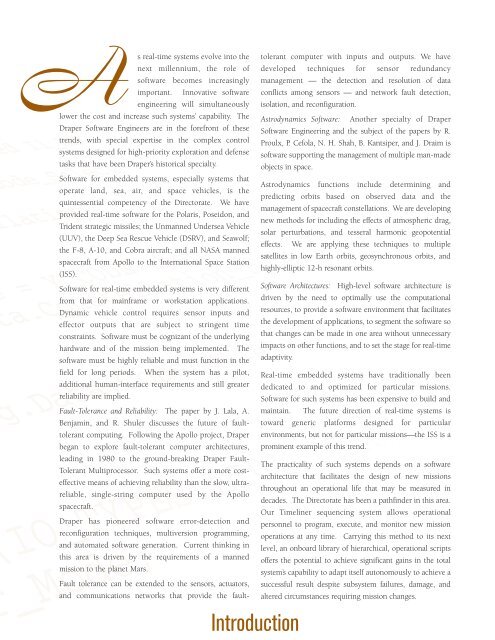1998 - Draper Laboratory
1998 - Draper Laboratory
1998 - Draper Laboratory
- No tags were found...
Create successful ePaper yourself
Turn your PDF publications into a flip-book with our unique Google optimized e-Paper software.
As real-time systems evolve into the tolerant computer with inputs and outputs. We havenext millennium, the role of developed techniques for sensor redundancysoftware becomes increasingly management — the detection and resolution of dataimportant. Innovative software conflicts among sensors — and network fault detection,engineering will simultaneously isolation, and reconfiguration.lower the cost and increase such systems’ capability. The<strong>Draper</strong> Software Engineers are in the forefront of thesetrends, with special expertise in the complex controlsystems designed for high-priority exploration and defensetasks that have been <strong>Draper</strong>’s historical specialty.Astrodynamics Software: Another specialty of <strong>Draper</strong>Software Engineering and the subject of the papers by R.Proulx, P. Cefola, N. H. Shah, B. Kantsiper, and J. Draim issoftware supporting the management of multiple man-madeobjects in space.Software for embedded systems, especially systems thatAstrodynamics functions include determining andoperate land, sea, air, and space vehicles, is thepredicting orbits based on observed data and thequintessential competency of the Directorate. We havemanagement of spacecraft constellations. We are developingprovided real-time software for the Polaris, Poseidon, andnew methods for including the effects of atmospheric drag,Trident strategic missiles; the Unmanned Undersea Vehiclesolar perturbations, and tesseral harmonic geopotential(UUV), the Deep Sea Rescue Vehicle (DSRV), and Seawolf;effects. We are applying these techniques to multiplethe F-8, A-10, and Cobra aircraft; and all NASA mannedsatellites in low Earth orbits, geosynchronous orbits, andspacecraft from Apollo to the International Space Stationhighly-elliptic 12-h resonant orbits.(ISS).Software for real-time embedded systems is very differentfrom that for mainframe or workstation applications.Dynamic vehicle control requires sensor inputs andeffector outputs that are subject to stringent timeconstraints. Software must be cognizant of the underlyinghardware and of the mission being implemented. Thesoftware must be highly reliable and must function in thefield for long periods. When the system has a pilot,additional human-interface requirements and still greaterreliability are implied.Software Architectures: High-level software architecture isdriven by the need to optimally use the computationalresources, to provide a software environment that facilitatesthe development of applications, to segment the software sothat changes can be made in one area without unnecessaryimpacts on other functions, and to set the stage for real-timeadaptivity.Real-time embedded systems have traditionally beendedicated to and optimized for particular missions.Software for such systems has been expensive to build andFault-Tolerance and Reliability: The paper by J. Lala, A. maintain. The future direction of real-time systems isBenjamin, and R. Shuler discusses the future of faulttolerantcomputing. Following the Apollo project, <strong>Draper</strong>began to explore fault-tolerant computer architectures,toward generic platforms designed for particularenvironments, but not for particular missions—the ISS is aprominent example of this trend.leading in 1980 to the ground-breaking <strong>Draper</strong> Fault-The practicality of such systems depends on a softwareTolerant Multiprocessor. Such systems offer a more costeffectivemeans of achieving reliability than the slow, ultra-architecture that facilitates the design of new missionsthroughout an operational life that may be measured inreliable, single-string computer used by the Apollodecades. The Directorate has been a pathfinder in this area.spacecraft.Our Timeliner sequencing system allows operational<strong>Draper</strong> has pioneered software error-detection andreconfiguration techniques, multiversion programming,and automated software generation. Current thinking inthis area is driven by the requirements of a mannedmission to the planet Mars.Fault tolerance can be extended to the sensors, actuators,and communications networks that provide the faultpersonnelto program, execute, and monitor new missionoperations at any time. Carrying this method to its nextlevel, an onboard library of hierarchical, operational scriptsoffers the potential to achieve significant gains in the totalsystem’s capability to adapt itself autonomously to achieve asuccessful result despite subsystem failures, damage, andaltered circumstances requiring mission changes.Introduction
















